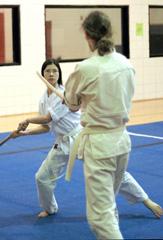
John Cosgrove
At first glance, the Aikido Club looks relatively small and timid.
That is, until members start throwing each other around the room. It is a martial arts club where students learn how to defend themselves by using their opponents’ own force against them.
“Aikido focuses on redirecting whatever momentum people throw at you, and you do not counter and take the entry force,” Sarah Suda, president of the club and a senior in physics, said.
Since aikido is a noncombative style, it’s not about hurting your opponent by using a lot of strength, according to Myles Casanova, a sophomore in political science. It’s about ending a conflict safely so no one gets hurt.
Aikido is a Japanese tradition directly derived from samurai lineage. In the club members’ dojo, all of the formalities and traditions of an aikido dojo are followed. The teacher wears a hakama, traditional clothing of a samurai, and a picture of the founder of aikido sits in the front of the room.
“We pay our respect [to the founder] by bowing when we enter and exit the mat,” Suda said. “There is just a lot of bowing and protocol that we have to do that is associated with this martial art.”
Mike Carnes, an alumnus and one of the teachers for aikido, said the club keeps a very formal environment on the mat because it is the best way to learn.
“Goofing off and playing around — that’s how your technique will be as well,” he said. “That is why you have to really focus and train.”
Some of the members joined the Aikido Club because they wanted to learn a martial art, and it seemed to suit them. Because the club is relatively small, its size helps people learn to work with others and understand the goals and protocol of the club.
But unlike other martial arts clubs, aikido is not a sport and remains a noncompetitive club at N.C. State.
“Aikido is different because there is not a lot of competition,” Suda said. “We do not have competitions, and your belt stays white until you become a black belt, which eliminates unneeded showboating and ego trips.”
Carnes started learning aikido while he was a freshman at State.
“I came out, and I saw people flying around in the air, and I thought it was cool,” Carnes said. “I still have a lot to learn, and I enjoy getting a chance to teach these guys.”
In aikido there is dodging and diverging, Suda said. In the first part of the club’s practices, the members focus on rolling and falling.
“One thing about aikido is that half of it is being thrown, and the other half is throwing,” Carnes said. “It’s important in aikido to learn both sides of the coin.”
Although aikido may be different in its approach to defense, it still holds the fundamentals aspects of martial arts.
“It’s all the way that you carry your balance and the way that you are centered,” Carnes said. “It’s something you learn in all martial arts.”